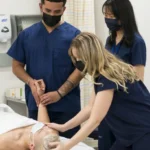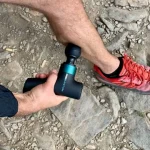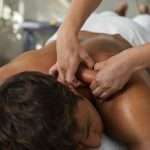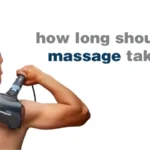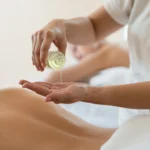As a massage therapist with over 10 years of clinical experience, I’ve seen firsthand how facial tissues respond to various treatments—including cosmetic fillers. When clients ask me about massaging their lip fillers, especially when they’ve noticed migration, I always emphasize one thing: professional knowledge matters.
In this comprehensive guide, I’ll share my professional perspective on:
- What lip filler migration really is (from someone who understands tissue manipulation)
- When massage might help—and when it definitely won’t
- What you should know before booking a facial massage with fillers
- The safest approaches backed by both manual therapy expertise and cosmetic professionals
Let’s clear up the confusion and protect your investment in your lips 👇
Table of Contents
🧾 Quick Summary: A Massage Therapist’s Perspective
Before we dive deep, here’s what you need to know:
- 💉 Lip filler can migrate due to overfilling, technique, or natural facial movement patterns
- 👐 Professional facial massage differs significantly from self-massage attempts
- 🙅 Most migration issues require dissolution, not massage—especially after the first few days
- 🔄 Understanding tissue response is key to prevention and treatment
- 🛡️ Communication between your massage therapist and injector is crucial for your safety
💡 Understanding Lip Filler Migration: A Tissue Perspective
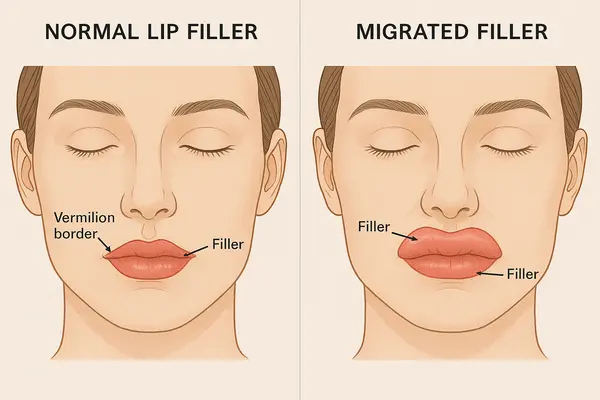
Lip filler migration happens when the injected product (usually hyaluronic acid-based) moves beyond the intended treatment area. As someone who works with facial tissues daily, I understand that your facial tissues function as interconnected systems.
When filler migrates, you might notice:
- A blurry or undefined lip border
- A “filler mustache” appearance
- Lumpy or uneven lips
From a tissue perspective: Migration isn’t just about the product—it’s about how your unique facial anatomy responds to it. Your facial muscles, connective tissue structure, and daily movement patterns all play crucial roles that injectors might not fully address.
🔍 Recognizing Migrated Filler: What I See in Practice
In my massage practice, I frequently work with clients who have had facial fillers. Here’s what I look for when assessing potential migration:
- Swollen or puffy areas above the lip border
- Asymmetry in facial movement patterns
- Tissue texture changes outside the intended treatment area
- Blurred or less-defined lip lines
- Facial tension patterns that might contribute to migration
Professional insight: As a massage therapist, I notice that clients who hold tension in their orbicularis oris (the muscle surrounding the mouth) often experience more migration issues—something that isn’t always addressed in cosmetic settings.
👐 The Massage Connection: Why Most Self-Massage Attempts Fail
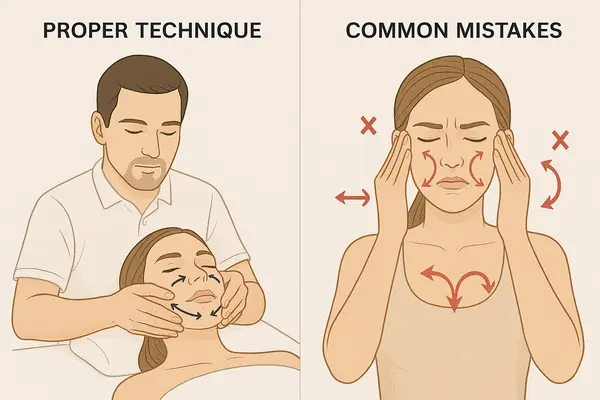
As a licensed massage therapist, I need to be clear: there’s a world of difference between professional therapeutic facial massage and what most people do at home when they feel lumps or migration.
Professional vs. Self-Massage for Fillers:
| Professional Therapeutic Massage | Common Self-Massage Attempts |
| Precise pressure and direction based on tissue anatomy | Random pressing and rubbing |
| Understanding of facial muscle layers and function | Focus only on the visible problem area |
| Integration with broader facial tension patterns | Isolated approach that ignores connected tissues |
| Customized technique based on filler type and placement | One-size-fits-all approach |
| Consideration of healing timeline | Often done too aggressively or too soon |
Real client experience: One of my clients attempted to “massage away” her migrated filler for weeks before seeing me. The excessive manipulation actually pushed the filler further into her nasolabial folds, requiring more complex correction later.
⚠️ When Massage Can Make Migration Worse: A Therapist’s Warning
From my clinical experience, I’ve observed several situations where massage attempts worsen filler migration:
- Aggressive pressure: Excessive force can displace filler further
- Incorrect direction: Massage in the wrong direction can spread filler unevenly
- Improper timing: Manipulation too soon after injection disrupts proper settling
- Underlying tension: Untreated facial tension patterns can redirect filler
Case study from my practice: A client came to me after noticing minor migration 3 days after injection. Following consultation with her injector, I performed a gentle, specialized technique that helped the filler integrate properly. Six months later, she still has beautiful results—because we addressed it correctly and promptly.
🧠 Understanding Facial Anatomy: A Massage Therapist’s Insight
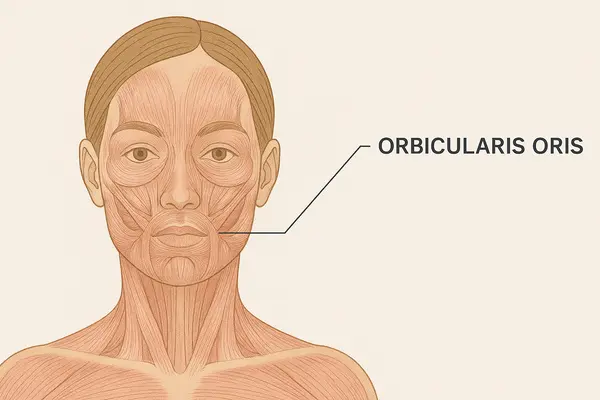
As a massage therapist, I work with facial tissues every day. Here’s what most people don’t realize about lip fillers from an anatomical perspective:
- The orbicularis oris muscle (surrounding your lips) is constantly in motion
- Your facial fascia (connective tissue) creates pathways where filler can migrate
- Habitual expressions create tension patterns that influence filler movement
- The lymphatic drainage of your face affects how fillers settle and resolve
My professional observation: Clients with strong muscle movement around their mouth (frequent speakers, singers, those with expressive faces) experience more migration issues than those with less active facial muscles.
✅ When Professional Facial Massage Might Help

In limited circumstances, professional facial massage can assist with filler issues when:
- It’s very early (within 1-3 days of injection)
- The migration is minimal (small lumps or slight unevenness)
- It’s performed by someone with specific training in working with cosmetic fillers
- Your injector has approved the treatment
The technique would involve:
- Gentle, directional pressure (not circular rubbing)
- Focus on surrounding tissues, not just the filler itself
- Integration with overall facial tension patterns
- Careful attention to proper lymphatic flow
Important distinction: This is not the same as rubbing your lips at home. Professional facial massage uses specific techniques that consider depth, direction, and surrounding tissue function.
🚫 Why Self-Massage Usually Fails: A Tissue Explanation
When clients show me how they’ve been trying to massage their own fillers, I immediately understand why they’ve had poor results. Self-massage for fillers typically fails because:
- Without anatomical knowledge, you’re working blind
- Pressure is often applied too deeply or too superficially
- Direction matters—random movements can worsen spreading
- Surrounding tension patterns are ignored
- The “referred pain” phenomenon can make it hard to identify the true problem area
What I tell my clients: “If you wouldn’t try to perform your own injection, you shouldn’t try to fix migration on your own either.”
💉 Understanding Hyaluronidase: The Definitive Solution

As a massage therapist, I recognize the limitations of my profession. For true filler migration, hyaluronidase (a dissolving enzyme) is typically the most effective solution:
- It specifically targets hyaluronic acid fillers
- It works precisely in the areas where it’s injected
- Results begin within 24-48 hours
- It’s the gold standard for correction
My professional recommendation: While I can help with facial tension that might contribute to migration, I always refer clients with significant migration to their injector for dissolution treatment.
🤝 What to Tell Your Massage Therapist About Your Fillers
If you’re booking a facial massage and have fillers, here’s what you should disclose:
- When you had your most recent injection (exact date)
- What type of filler was used and where
- Any migration or complications you’ve noticed
- Whether your injector has approved massage
- Any previous correction attempts
This information helps me adjust my technique to protect your investment while still providing effective treatment for facial tension.
🛡️ Prevention Strategies: A Massage Therapist’s Approach

As someone who understands how tissues respond to manipulation, here are my top recommendations for preventing filler migration:
- Address facial tension patterns before getting fillers
- Be mindful of habitual expressions that might affect filler placement
- Stay hydrated to maintain optimal tissue function
- Consider your speaking/expression patterns when discussing placement with your injector
- Establish communication between your massage therapist and injector
- Follow aftercare guidelines meticulously, especially regarding facial manipulation
Professional tip: I often recommend clients have a facial massage 2-3 weeks before fillers to address tension patterns, then wait at least 2 weeks post-injection before resuming facial massage.
❓ FAQs: Questions My Clients Ask About Massage and Fillers
Can facial massage help prevent migration before it happens? Possibly. Addressing facial tension patterns and ensuring proper lymphatic drainage before and after (with appropriate timing) may help fillers settle more naturally.
How soon after getting lip filler can I get a professional facial massage? Most injectors recommend waiting at least 2 weeks. I personally won’t perform focused facial massage on clients until they’re 14+ days post-injection.
Will facial massage dissolve my fillers faster? Therapeutic massage shouldn’t significantly accelerate natural dissolution, but overly aggressive massage might affect your results negatively.
Should I tell my massage therapist about my fillers even if I’m not getting facial massage? Absolutely—even neck massage can indirectly affect facial tissues, and we may need to adjust techniques accordingly.
Can massage prevent the need for dissolution if I notice early migration? Only in very minor cases with proper technique and timing. For noticeable migration, dissolution is typically necessary.
📝 Final Thoughts: A Massage Therapist’s Perspective
As a massage therapist who frequently works with clients before and after cosmetic procedures, I’ve gained unique insight into how tissues respond to fillers. The most important takeaway: respect the complexity of your facial anatomy.
When it comes to lip filler migration, professional guidance is essential. While massage has its place in facial wellness, it’s rarely the complete solution for migration issues. Trust trained professionals who understand both the product and your unique facial structure.
Whether you’re considering fillers, currently have them, or are dealing with migration, remember that your face is a complex, interconnected system—treat it with the expertise it deserves.
📚 Sources and Further Reading
- Akin, A., & Ozturk, M. (2023). Anatomy, Head and Neck, Orbicularis Oris Muscle. Read More
- American Massage Therapy Association. “Working with Clients with Cosmetic Fillers.” (2023) Read More
- Journal of Clinical and Aesthetic Dermatology. “Complications of Soft Tissue Fillers and Their Management.” (2022) Read More
- National Library of Medicine. “Treatment of Soft Tissue Filler Complications: Expert Consensus Recommendations” (2018). Read More
⚠️ Disclaimer:
This article is for informational purposes only and does not constitute medical advice. Always consult with a licensed healthcare provider or certified massage therapist before beginning any new treatment, especially if you have pre-existing health conditions or concerns.




